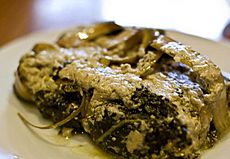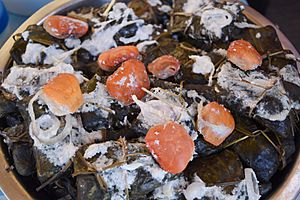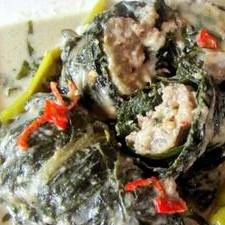Laing (food) facts for kids
 |
|
| Alternative names | pinangat, laing pinangat, pinangat na laing, pinangat na gabi, ginataang laing |
|---|---|
| Type | Stew |
| Place of origin | Philippines |
| Region or state | Bicol Region |
| Created by | Filipino cuisine |
| Main ingredients | Taro leaves, chili, meat or seafood, coconut milk |
| Variations | inulukan, tinumok, linapay |
| Similar dishes | sinanglay, Bicol Express, gising-gising |
Laing (say "LAH-ing") is a yummy Filipino dish. It's made with taro leaves, which are like big green leaves. These leaves are cooked in creamy coconut milk. The dish gets its spicy kick from chili peppers. It also has lemongrass, garlic, shallots, ginger, and shrimp paste for extra flavor.
Sometimes, laing includes meat or seafood. This dish comes from the Bicol Region in the Philippines. In Bicol, it's often just called pinangat. Since it uses coconut milk, it's also known as ginataang laing. People usually eat laing as a vegetable side dish with rice and other main dishes.
What is Laing Called?
The name laing is used in most parts of the Philippines. But sometimes, it can be confused with pinangat na isda. That's a different dish made with fish cooked in a slightly sour soup. The word pangat originally meant cooking fish or meat in water and salt.
Laing is a classic dish from the Bicol Region. Bicolano food is famous for using lots of chili peppers and coconut milk. Besides laing, it's also called ginataang laing, pinangat na laing, pinangat na gabi, and ginat-ang gabi.
How Laing is Made
The original laing from the Bicol Region uses a whole taro leaf. This version is often called pinangat. Inside the leaf, there's usually a mix of pork, shrimp, or fish. It also has shrimp paste, crushed chili peppers, garlic, shallots, and ginger. All of this is mixed with thick coconut cream.
The leaf is wrapped around the mixture and tied up. Then, it's steamed in more coconut milk with lemongrass. It cooks until the leaves are soft and the coconut milk becomes a thick sauce.
In other places like Manila, laing is made with shredded taro leaves. It often includes the chopped leaf stalks too. Laing is usually eaten with white rice. You can also put it in bread like pandesal or use it as a filling for other foods. It's a popular side dish with meat.
It's important to prepare taro leaves carefully. They have tiny crystals that can make your mouth feel itchy or burning. Washing and cooking them well helps avoid this. Drying the leaves can also reduce these crystals.
Different Kinds of Laing
There are a few interesting types of laing:
Inulukan
Inulukan (or inulokan) is a laing dish made with river crabs. The crab meat is wrapped in whole taro leaves. It's cooked in coconut milk with calamansi, black pepper, and lemongrass. This special dish comes from Camalig, Albay.
Linapay
Linapay (also called tinamuk) is a similar dish from Aklan in the Western Visayas. It uses crushed freshwater shrimp mixed with grated young coconut meat. This mixture is wrapped in taro leaves and cooked in coconut milk.
Tinumok
Tinumok (or tinulmok) is another traditional Bicolano variant. It uses whole taro leaves wrapped around a mix of freshwater shrimp and fish flakes. Sometimes it also has meat. It includes shrimp paste, grated coconut, onions, chilis, lemongrass, and garlic. All of this is cooked in coconut milk. The main difference is that tinumok uses grated coconut meat in its filling.



